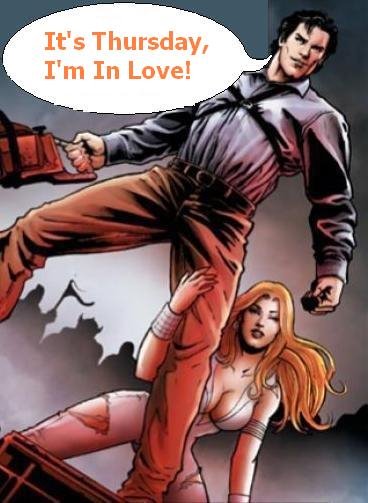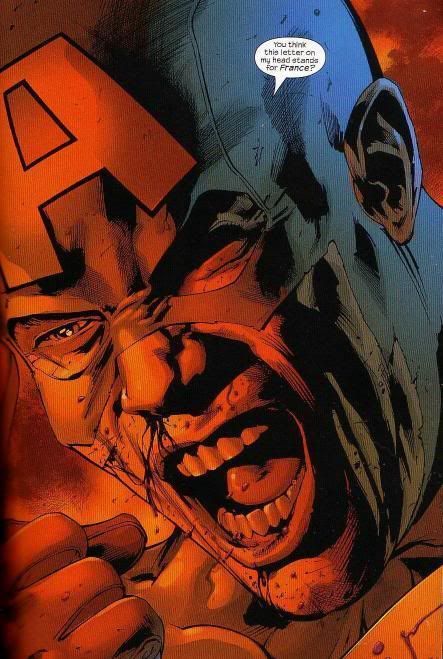Dynamite Entertainment is about to publish a new series titled Superpowers by Alex Ross and I'll certainl be purchasing this series when it's out! Alex Ross rocks!
THE WIZARD SKETCHBOOK: ALEX ROSS
Compare the artist’s dynamic revamps for Dynamite’s upcoming ‘Superpowers’ series with their Golden Age counterparts
By Danny Spiegel | Posted October 5, 2007 4:10 PM |
Look out world, guess who’s back! It’s the Black Terror! The Crusaders! The Owl! The Death-Defying Devil! Hey, wait a minute! Who are these guys?! Well, they’re the forgotten creations of several now-defunct comics companies from the ’30s and ’40s who, now that they’ve lapsed into the public domain (which means anyone can creatively nab them), are being reimagined courtesy of superstar artist Alex Ross for Dynamite’s Superpowers series. “I didn’t want to necessarily update anybody if there was no reason to do it,” says Ross. “It’s all about putting a little bit of a fresh coat of paint on it.” And now, before their triumphant return (er, “debut”?) in December, we get an exclusive preview comparing Ross’ sketches of each character’s original design with their all-new, full-color versions.
DEATH-DEFYING DEVIL
Ross: “Back in the ’40s he was one of the most popular characters of that era because it was such a great visual look. It’s really the precursor to Spider-Man’s look, the split face with the skintight mask that you don’t know how the hell that’s being worn by anybody. It’s that kind of Mr. Miracle substance that sticks to one’s features and allows the mouth to move. So with him I didn’t change much. It’s basically all in the finish of how to illustrate him, making him look more like a wet, high-gloss, like he’s wearing that latex fetish wear kind of thing that seems like a skin.”
Ross: “Back in the ’40s he was one of the most popular characters of that era because it was such a great visual look. It’s really the precursor to Spider-Man’s look, the split face with the skintight mask that you don’t know how the hell that’s being worn by anybody. It’s that kind of Mr. Miracle substance that sticks to one’s features and allows the mouth to move. So with him I didn’t change much. It’s basically all in the finish of how to illustrate him, making him look more like a wet, high-gloss, like he’s wearing that latex fetish wear kind of thing that seems like a skin.”
SAMSON
Ross: “The idea of Samson is that he’s been wandering the Earth for 60 years and this version embraces the idea of him possibly being the biblical Samson or maybe even just thinking he is. The mark that he wears as a pendant is actually the last letter of the actual Hebrew translation of the name ‘Samson.’ And, of course, the bandages over his eyes are indicating that he’s blinded like the classic Samson. The cape plays towards the idea that if he’s now walking around as a blind man, including a walking staff, that it’s somewhat like a hiding, a withdrawing from society. Not being quite as naked.”
Ross: “The idea of Samson is that he’s been wandering the Earth for 60 years and this version embraces the idea of him possibly being the biblical Samson or maybe even just thinking he is. The mark that he wears as a pendant is actually the last letter of the actual Hebrew translation of the name ‘Samson.’ And, of course, the bandages over his eyes are indicating that he’s blinded like the classic Samson. The cape plays towards the idea that if he’s now walking around as a blind man, including a walking staff, that it’s somewhat like a hiding, a withdrawing from society. Not being quite as naked.”
THE CRUSADERS
Ross: “Some characters have been abused by the government. They’ve been cloned in effect to create a controllable form of superhuman power. Basically, the American Crusader is a form of a black ops elite that’s used for quick seek-and-destroy type of material. I treated the classic circular symbol of the character as just a marking for what is ultimately a black-clad stealth fighter in human form.”
Ross: “Some characters have been abused by the government. They’ve been cloned in effect to create a controllable form of superhuman power. Basically, the American Crusader is a form of a black ops elite that’s used for quick seek-and-destroy type of material. I treated the classic circular symbol of the character as just a marking for what is ultimately a black-clad stealth fighter in human form.”
THE BLACK TERROR
Ross: “The Black Terror predates many other skull-wearing, black-clad heroes. He’s a super-strong character that’s driven to beat up his enemies; there’s a bare-knuckled quality to the character. And it seems as if the skull and crossbones on his chest glows within a void of black. The black of his costume [around his head] is treated as if it’s almost overtaking him in the form of his mask. He’s being enveloped by the darkness. The gloves and boots extend the idea of the character as somewhat of a superhero pirate, in effect. The buccaneer-style boots and gloves are really just a folding-down of the old [versions].”
Ross: “The Black Terror predates many other skull-wearing, black-clad heroes. He’s a super-strong character that’s driven to beat up his enemies; there’s a bare-knuckled quality to the character. And it seems as if the skull and crossbones on his chest glows within a void of black. The black of his costume [around his head] is treated as if it’s almost overtaking him in the form of his mask. He’s being enveloped by the darkness. The gloves and boots extend the idea of the character as somewhat of a superhero pirate, in effect. The buccaneer-style boots and gloves are really just a folding-down of the old [versions].”
THE OWL
Ross: “Originally The Owl’s mask design had a nose beak on the front of it much like Nighthawk did when he first appeared, and so I streamlined that into a shape that was coming off of the forehead. So, in a way, there is now the indication of where a Spider-Man [type] of nose impression comes through of the man underneath. And the design of the owl-like shape is [no longer] making this ridiculous yellow nose shape. And the ‘V’ with the two circles underneath is a graphic symbol I’ve already designed for a character that appeared in Astro City [Simon Magus] so I’m kind of extending it to this here.”
Ross: “Originally The Owl’s mask design had a nose beak on the front of it much like Nighthawk did when he first appeared, and so I streamlined that into a shape that was coming off of the forehead. So, in a way, there is now the indication of where a Spider-Man [type] of nose impression comes through of the man underneath. And the design of the owl-like shape is [no longer] making this ridiculous yellow nose shape. And the ‘V’ with the two circles underneath is a graphic symbol I’ve already designed for a character that appeared in Astro City [Simon Magus] so I’m kind of extending it to this here.”
MR. FACE
Ross: “I always liked the design of a character that has that Creeper-like quality of being a ‘good guy’ Joker. And so the effect of a man with a monster face and a tuxedo is just such a simple, cool idea that I want to take this character and do something with him—where the effect of his face has a surreal quality on people much like Count Vertigo, where it sort of throws you off in a scarecrow-like manner once he enters the room. You’re actually terrorized by the effect of that mask.”
Ross: “I always liked the design of a character that has that Creeper-like quality of being a ‘good guy’ Joker. And so the effect of a man with a monster face and a tuxedo is just such a simple, cool idea that I want to take this character and do something with him—where the effect of his face has a surreal quality on people much like Count Vertigo, where it sort of throws you off in a scarecrow-like manner once he enters the room. You’re actually terrorized by the effect of that mask.”
THE AMERICAN SPIRIT
Ross: “The idea is animating the flag as a source of inspiration for all flag-clad characters over time. Tons of guys were based upon the flag in the ’40s—the Archie Comics Shield character, Captain America, Wonder Woman and countless others followed. It’s this continual inspiration, giving form as its own entity that it is actually self-aware. You just take the flag and drape it like the shroud of some ghost and you suddenly have a new character.”
Ross: “The idea is animating the flag as a source of inspiration for all flag-clad characters over time. Tons of guys were based upon the flag in the ’40s—the Archie Comics Shield character, Captain America, Wonder Woman and countless others followed. It’s this continual inspiration, giving form as its own entity that it is actually self-aware. You just take the flag and drape it like the shroud of some ghost and you suddenly have a new character.”



No comments:
Post a Comment